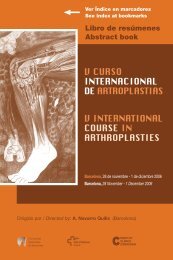Notas / Notes - Active Congress.......
Notas / Notes - Active Congress.......
Notas / Notes - Active Congress.......
You also want an ePaper? Increase the reach of your titles
YUMPU automatically turns print PDFs into web optimized ePapers that Google loves.
JUEVES / THURSDAY<br />
138<br />
to numb areas but occasionally can cause extreme pain.<br />
Some approaches are influencing the innervation of the vastus<br />
medialis. Different patterns of this nerve can be described.<br />
Saving the supra- and infra-patellar fat pad has several benefits.<br />
This is important for the patellar blood supply, but also<br />
has biomechanical implications and obscures visualization<br />
of the lateral compartment.<br />
The medial supporting structures are to be respected. Care<br />
should also be taken to the postero-lateral corner during the<br />
balancing and releasing action in this area. Always remember<br />
the minimal distance between the posterior capsule and the<br />
popliteal artery in extension and flexion. As shown by prof. M.<br />
Prettenklieber (Vienna) the distance between the joint capsule<br />
and the popliteal artery is subject to a high degree of variations<br />
and ranges from 2 to 37 mm. It may even decrease in flexion!<br />
The potential pitfalls are iatrogenic!<br />
Our message is :please take care of the important soft tissues<br />
during MIS Total Knee Replacement. Therefore we need to<br />
know anatomy and train our retractor management and assistant<br />
team choreography.<br />
REFERENCES<br />
1. Avoiding the Potential Pitfalls of Minimally Invasive Total<br />
Knee Surgery. Keith Berend and Adolph Lombardi. Orthopedics<br />
2005; 28: 1326<br />
2. Minimal-Incision Total Knee Arthroplasty. M Tenholder and<br />
Giles Dcuderi. Clin Orthop and Rel Res nr 440,p.67-76,<br />
2005<br />
PITFALLS & COMPLICATIONS OF MIS TKA<br />
Peter Bonutti, MD<br />
Bonutti Clinic. Effingham, Illinois (USA)<br />
The purpose of this study was to identify the main pitfalls and<br />
complications associated with minimally invasive total knee<br />
arthroplasty and to describe and define a set of techniques<br />
and tips for avoiding or compensating for these difficulties.<br />
To provide this evaluation, we retrospectively evaluated a<br />
single author’s series of 1,500 consecutive minimally invasive<br />
total knee arthroplasties. The surgeries included in this study<br />
were defined in terms of four categories that minimized the<br />
invasiveness of the TKA:1) Using an incision of 10 centimeters<br />
or less; 2) Reducing the amount of soft tissue disruption,<br />
specifically damage to the quadriceps muscle which typically<br />
incorporates splitting of this muscle; 3) Trying to not dislocate<br />
the patella (subluxing the quadriceps mechanism rather than<br />
completely everting the patella); and 4) Minimizing the amount<br />
of knee joint dislocation (tibial-femoral dislocation).<br />
The study design is a retrospective analysis of patients who<br />
underwent minimally invasive total knee arthroplasty from<br />
January 1999 to January 2007. The data collection included<br />
implant type, need for lateral release, incision size, tourniquet<br />
time, and any intraoperative and postoperative complications.<br />
Preoperative and postoperative data included age, gender,<br />
weight, diagnosis, and Knee Society scores including pain,<br />
stability and range of motion. In addition, a radiographic review<br />
was conducted.<br />
The entire study cohort included 1022 unilateral TKAs and<br />
478 bilateral TKAs in 641 males and 853 females. The mean<br />
Knee Society objective scores improved from 42.9 points<br />
preoperatively to a mean of 93.8 points postoperatively.<br />
Similarly, the Knee Society Functional Scores improved from<br />
48.7 points to 95.2 points at final followup.<br />
There were 62 complications that required any type of intervention<br />
of the 62 revision total knee arthroplasties, 35 were manipulation<br />
under anesthesia, 17 were arthroscopic procedure,<br />
4 soft tissue release and retained cement removal, 4 were full<br />
component revisions (2 for deep infection,1 for suspected<br />
infection but not negative culture,1 for traumatic instability), 3<br />
were tibial component revisions (aseptic loosening, pain), 1<br />
was polyethylene spacer exchange for extensive wear, 1 was<br />
a femur revision, and 1 was a revision from a cemented system<br />
to a cementless for PMMA allergy diagnosed by a dermatologist.<br />
Although the overall tibiofemoral angles averaged 5.4° valgus,<br />
we had some radiographic outliers. Several patients demonstrated<br />
with tibia varus of greater than 3°. These patients are<br />
at increased risk for early aseptic tibial loosening.<br />
Clearly there are risks associated with any new surgical techniques<br />
and most complications occurred early in the learning<br />
curve, although, complications did occur throughout the entire<br />
series. Nevertheless, MIS TKA principles can provide excellent<br />
results, fast recovery, and perhaps less postoperative pain<br />
with improved quadriceps function.<br />
MIS IN TKA<br />
Damian Griffin<br />
Warwick Medical School. Coventry (Great Britain)<br />
MINI-INCISION TKA<br />
David Dalury<br />
John Hopkins Hospital. Baltimore (USA)<br />
Smaller incisions are a natural consequence of surgeon confidence<br />
and experience, instrument design and patient demands.<br />
Several authors have found no increase in complications with<br />
smaller incisions while others have documented more problems<br />
with alignment of implants and wound problems when trying<br />
to minimize the skin incision. While the theoretical advantages<br />
of Mini incision TKR are easier recoveries for patients, surgeons<br />
should never compromise outcomes simply for a smaller incision.<br />
This paper will discuss the pros and cons of MiTKR.





